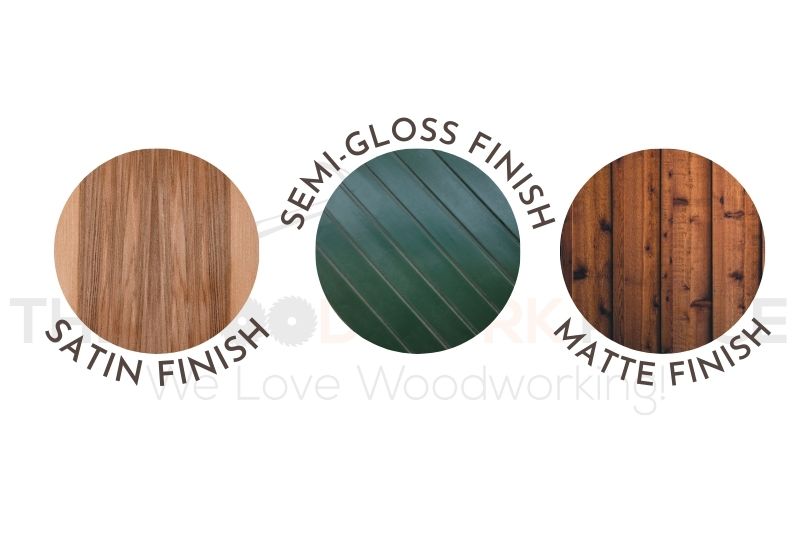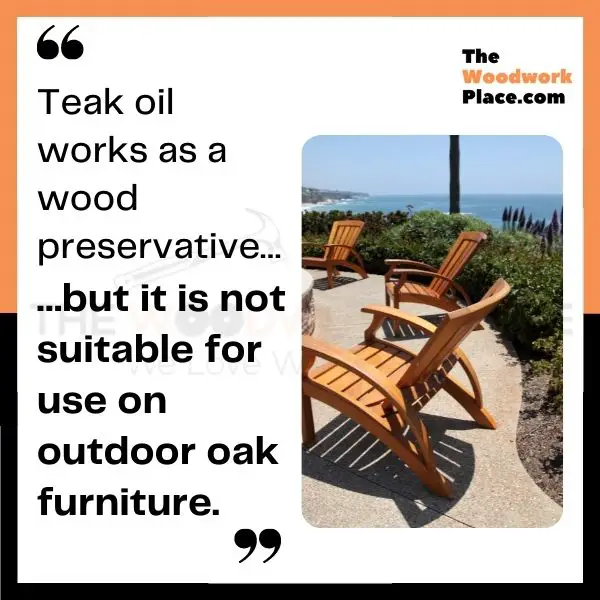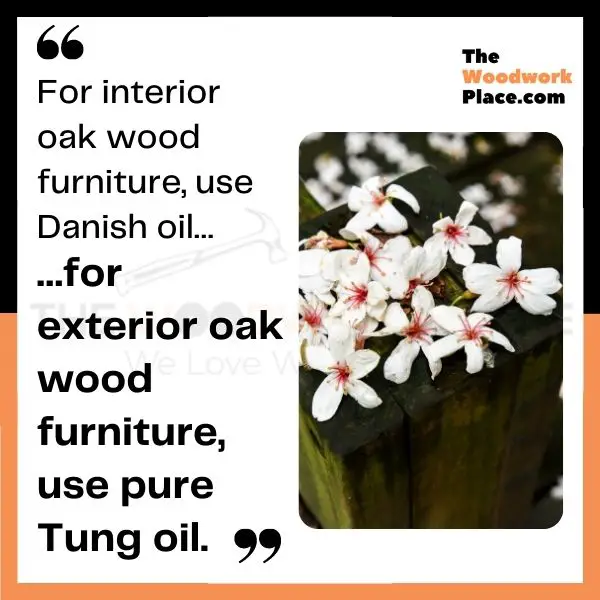Oak wood is a rather durable and long-lived lumber. Left untreated, this hefty hardwood can last for decades, all thanks to its natural resistance to rot and decay.
But even furniture made from dense oak heartwood can benefit from a wood preserving oil finish.
Now, all penetrating oil finishes, (such as Danish oil and Teak oil), work by soaking into wood. And as they do, they coat wood fibers with a solid water-repellent resin.
But, when it comes to oak wood, does the type of oil you use really matter? Or is teak oil a good a finish as any on oak?
Related Post: Can You Apply Teak Oil On Maple Wood? (Best Practice Revealed)
Well, that’s what we’re going to cover in this post. So keep reading to learn why Teak oil is better off used on interior oak furniture pieces.
You will also discover why using an oil finish is so important, if you want to let oak wood ‘breathe’. And we reveal the two best oil finish choices on either interior and exterior oak wood.

This post may contain affiliate links to products that we receive a commission for (at no additional cost to you). Learn more here.
What Kind Of Wood Can You Use Teak Oil On?
Teak oil works best on interior furniture, and should not be used on outdoor furniture.
Which is surprising, because teak oil was originally made as an oil finish for teak wood, (which is popularly used for outdoor structures and decking).
But, in all honesty, teak wood doesn’t need teak oil (or any oil for that matter).
Related Post: Can You Apply Lemon Oil On A Teak Wood Surface?
That is because teak wood is a naturally oily wood. In fact, it is so oily, it doesn’t need a penetrating wood finish as a preservative.
However, teak oil finishes do not contain any natural teak wood oil. Instead, the teak oil sold as a wood finish is made from a blend of Linseed oil or Tung oil, plus solvents and varnish.
But, the exact ingredients in teak oil can vary wildly from brand to brand. In other words, no two teak oil products are the same.
Does Teak Oil Protect Wood?
Well, teak oil is best used as a wood preservative. This means it can help to make wood grain less water absorbent, and prevent lumber from drying out into a husk of its former self.
But teak oil is not a waterproof sealer and it shouldn’t be used on outdoor furniture pieces. Teak oil particularly doesn’t do well in high humidity climates.
That is because, over time, mold can happily thrive on teak oil finishes. This is especially true if that teak oil product contains Linseed oil.
So, on one hand, teak oil can protect wood from the damage that rot and decay can do to timber. However, at the same time, teak oil can foster the growth of mold itself.
In short, teak oil can protect interior wood – in low humidity climates. Outside of that, however, there are much better oil finishing options for your favourite oak table.
Basically, as a wood finish, there is nothing that really sets Teak oil apart from the rest.
While Danish oil, Linseed oil, and Tung oil finishes range from satin to semi-gloss, Teak oil leaves oak wood surfaces with a matte appearance.

What Teak oil does do well enough, is allow wood to breathe. And that is because teak oil, (just like most drying oils), is a microporous finish.
Why Does Using A Microporous Finish Matter For Wood?
Wood is like a sponge when it comes to water.
When a tree is freshly cut, it has a moisture content of 100%, which means that there is a lot of water contained inside green wood.
Related Post: Can You Paint Green Wood? (Solved!)
After we season green wood, it’s moisture content falls down to below 20%. But, unless you are working with a complete dry husk of a wooden oak board, there is always at least a little water content inside wood.
Which is a good thing, because working with rock-hard dry lumber isn’t easy!
Related Post: How To Soften Wood For Carving (Explained)
Now, when you seal wood grain with an oil finish, any moisture left inside wood gets trapped underneath it. And on a warm day, that trapped moisture is going to turn into water vapor.
A microporous finish will allow water vapor to release as wood ‘exhales’ out that moisture.
This is why oil finishes (which are microporous) allow wood to breathe more than a plastic-type waterproofing sealant like polyurethane (which is not microporous).
But, a microporous finish isn’t waterproof. That’s because as sure as it lets water vapor out, it can let humid moisture vapor in too.
So, you should top coat a teak oil finish with a waterproof sealer (if you want to make this oil finish waterproof).

So Then, What Is The Best Oil To Use On Oak Wood?
It very much depends on whether that oak wood craft will be spending its time outdoors, or inside.
For Indoor Oak Furniture? Use Danish Oil
Danish oil is a blended finish made from Linseed oil, (sometimes Tung oil), mineral spirits, and varnish. And it also acts as a wood preservative.
Related Post: All About Danish Oil: Advantages and Disadvantages
Danish oil, just like Teak oil, is not waterproof (or even all that water resistant). And, in high humidity environments, black mold and mildew can also grow on this finish.
But, in dry room temperature environments, this oil finish does a fantastic job at finishing oak with a satin to semi-gloss appearance.
It is easy to apply, and it can dry in as little as 6 hours. Plus, it is incredibly simple to upkeep this finish too. Which is just as well, because Danish oiled surfaces need to be reapplied every 6-12 months.
One of the best Danish oil products on the market is Watco’s Danish Wood Finish. Available in 10 rich colors, it takes just six hours for 2 or 3 coats of this oil finish to dry.
You can find the latest prices for this Danish oil wood finish over on Amazon.
For Outdoor Furniture? Use Pure Tung oil
Tung oil, specifically pure Tung oil, dries slowly. In fact, Tung oil takes over four times as long as Danish oil, (or Teak oil), to dry and cure.
So don’t be surprised if you find yourself waiting 1-2 days for that Tung oil coat to dry.
That’s because Tung oil doesn’t have any dryer additives in it. And without dryer additives, (to help speed things up), Tung oil can take 30 days to cure.
However, pure Tung oil is a natural oil made from Tung tree seeds. Once extracted from those seeds, this pure oil has gone through a high-heat polymerization process.
And that process turns this natural oil into a wood finish that’ll dry and cure into a durable hard resin.
Related Post: Tung Oil Not Drying? (3 Simple Ways To Fix It)
This oil finish doesn’t darken wood, and it doesn’t yellow over time. But, what really sets Tung oil apart from Danish oil, Teak oil (and even Linseed oil), is the fact that this natural oil remains unaffected by mold and mildew.
So, even though Tung oil is not waterproof, it is humidity-resistant. Which makes it suitable as a wood preservative for outdoor structures. However, Tung oil will still need a waterproof sealant top coat to go over it, if you do decide to use it on outdoor oak.

Yet, there is one important caveat to all of this; make sure you use a pure Tung oil finish.
You see, lots of Tung oil products on the market are not Tung oil. In fact, many of them are more Teak oil than anything, blending natural oils with varnishes, polyurethane, and other thinners. And many faux-Tung oil products don’t contain any Tung oil at all.
If you use these faux-Tung oil products on oak, you will only end up with Teak oil style problems. However, if you want to stick to using a pure Tung oil product, use something like Liberons Premium Tung Oil Finish.
This finish stands heads and shoulders above other Tung oil products due to the fact that there are no additional dryers blended into this penetrating oil.
Plus, once this Tung oil has cured, it is non-toxic and food safe enough for it to be used to coat kitchen countertops and dining room tables.
You can find the very latest prices for this pure Tung oil finish over on Amazon.
Related Post: Is Oak Wood A Good Choice For Fence Posts?
To Sum Up, Here Are The 3 Key Takeaways…
1). Teak oil works as a wood preservative, but it is not suitable for use on outdoor oak furniture.
2). If you want an oil finish for interior oak wood furniture, use Danish oil.
3). And if you want an oil finish for exterior oak wood furniture, use pure Tung oil.



